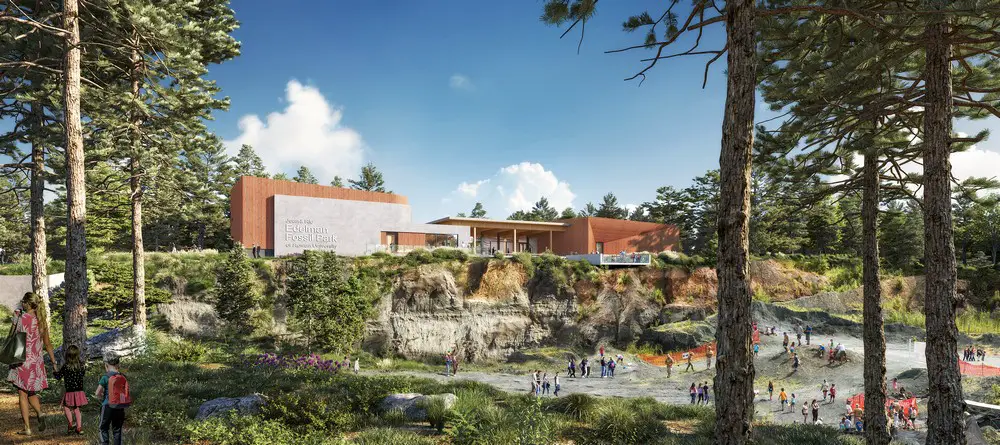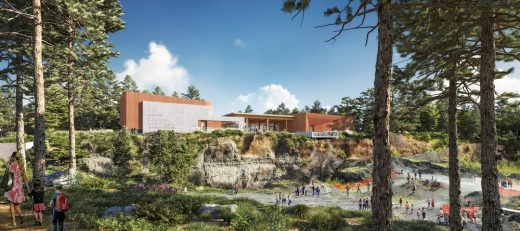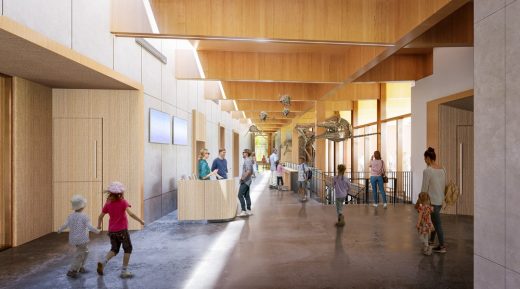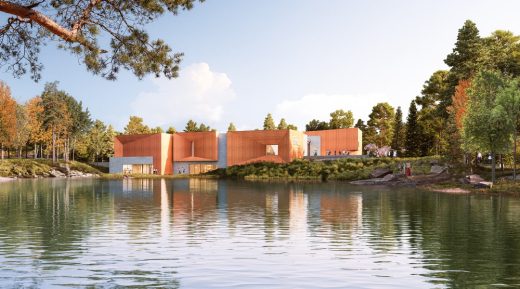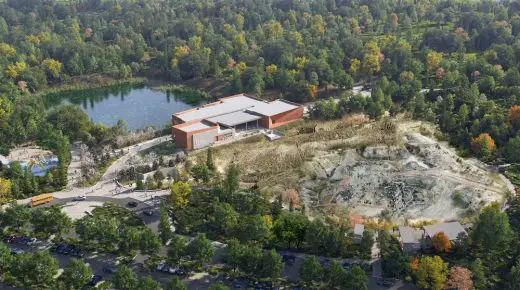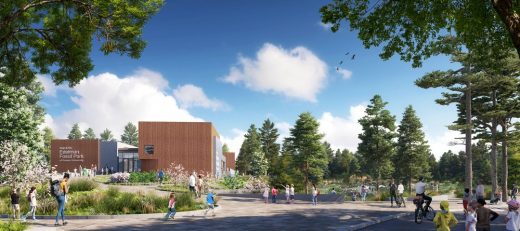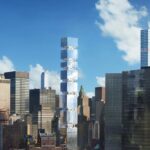Jean & Ric Edelman Fossil Park Museum, NJ Rowan University, Glassboro Architecture Images
Jean & Ric Edelman Fossil Park Museum in New Jersey
Oct 18, 2021
Design: Ennead Architects and KSS Architects
Location: Rowan University, Glassboro, New Jersey, USA
Jean & Ric Edelman Fossil Park Museum
Rowan University celebrated the groundbreaking of what will be New Jersey’s largest public net zero emissions building
Ennead Architects (Design Architect) together with KSS Architects (Architect of Record) officially unveiled designs for the highly-anticipated Jean & Ric Edelman Fossil Park Museum of Rowan University. The groundbreaking event for the project was celebrated over the weekend at the site in Mantua Township, New Jersey with leading paleontologist Dr. Kenneth Lacovara, executive director of the Fossil Park, U.S. Rep. Donald Norcross, and donors Jean and Ric Edelman.
Set into the 65-acre fossil park, the museum will perch above a four-acre former marl quarry where, within its muddy depths, 66-million-year-old marine and terrestrial fossils record the last moments of the dinosaur world. Centered around exploration, preservation, and education, the 44,000 square foot museum will feature an integrated design filled with immersive exhibits, surrounded by a network of nature trails and the quarry, where visitors can actively dig for fossils, alongside researchers working to uncover new information about the events that led to the world’s fifth mass extinction.
The Edelman Fossil Park Museum will be the largest public net zero emissions building in New Jersey and the first largest Living Building Challenge (LBC) building to achieve net zero energy in the state. The design team for the project is a collaboration between Ennead Architects, led by Ennead Design Partner Thomas J. Wong and Management Partner Don Weinreich, together with KSS Architects, led by KSS Partner Matthew McChesney, along with exhibit designers Gallagher & Associates and landscape designers SEED Design/Yaki Miodovnik.
Click here for renderings of the Edelman Fossil Park and Museum.
“When conceptualizing a design for the Edelman Fossil Park Museum, we drew inspiration from the incredibly unique nature of the site, as a window to another time on earth located in the most unlikely of places. The architecture functions as a set of conceptual lenses, each corresponding to a programmatic component and, much like a camera obscura, providing a glimpse of the realm beyond,” said Thomas J. Wong, AIA, Design Partner at Ennead Architects. “The deep-time perspective that the fossil record affords inspired a design that nestles within the natural landscape as a series of small-scale pavilions which serve to frame the evidence of past worlds, while opening up engagement with the present moment. Just as the site itself offers a view into the planet’s history and the devastation of mass extinction, the highly sustainable building looks to the future in the age of the Anthropocene.”
One of the project’s main goals is to encourage environmental stewardship, both through education and demonstration of high-performance sustainability throughout the building, which incorporates features such as geothermal wells that provide ground-source heating and cooling and a photo voltaic solar array. 100% of the energy used by the museum is planned to be supplied from renewable energy produced on-site. No fossil fuels will be combusted for museum operations and no greenhouse gasses will be released into the atmosphere.
“We are pleased to partner with Rowan University on this landmark project, which will serve an important role in educating and inspiring citizens to create a better shared future,” said Matthew McChesney, Partner at KSS Architects. “As an extension of the Rowan campus, the Edelman Fossil Park will further the University’s mission to become a new model for higher education and increase its impact as an economic engine for South Jersey.”
An economic impact study conducted ahead of the museum’s construction has predicted that an estimated 200,000 or more fossil hunters will visit the park and museum each year, producing more than $300 million in economic activity over a 10-year period.
Park Experience
The site plan is arranged carefully to maximize the visitor experience from entry to museum to quarry. Upon arrival, visitors are immediately enveloped in the landscape. Nature trails lead visitors to the learning experience inside the museum, which is followed by the discovery experience outside in the quarry, a sequence that is designed to unfold deliberately, as visitors transform into “citizen scientists.” Visitors are invited to dig for non-scientifically significant fossils in the quarry, which is home to thousands of fossils from the Late Cretaceous Period, when dinosaurs roamed the Earth.
Visitors engage in hands-on exploration alongside researchers working to uncover a high density of articulated fossils at the Cretaceous-Paleogene boundary, the geological plane below which all dinosaur fossils are found. After digging fossils in the quarry, patrons can take them back to the lab inside the building and have a paleontologist or student scientist help them understand what they have unearthed. The circulation and design offer a complete process from start to finish, integrating the experience inside and outside and accentuating connections between the various elements of the park.
Museum Experience
Much like the architecture, which was inspired by the idea that the site is a window through deep time, the museum itself is a metaphorical lens into the incredible history being uncovered at the site today. The learning center and exhibits give visitors an immersive and participatory experience centered around the story of the cretaceous seas, the cretaceous coast, and the transition from the age of dinosaurs to mammals.
The museum will feature three galleries with fossils from the Late Cretaceous Period, full-scale reconstructions of extinct creatures, hands-on learning experiences, live animal attractions, a fossil research workshop, a virtual reality chamber that transports visitors back to the era of the dinosaurs, a 150-seat theater and event space, and community gathering spaces with connections to the natural world. There will be a café with an outdoor veranda with a view to the quarry, a playground and gardens.
Research at the Site
Research at the site, led by Dr. Kenneth Lacovara, founding dean of Rowan’s School of Earth & Environment and director of the Jean & Ric Edelman Fossil Park Museum, is shedding light on ancient events that led to the fifth mass extinction, a calamitous die-off in which the dinosaurs (except for birds) and 75% of other species went extinct.
“The Jean & Ric Edelman Fossil Park & Museum will be a world-class destination for scientific discovery and citizen science,” said Dr. Kenneth Lacovara. He said the museum will also provide opportunities for the exploration of contemporary issues, like the rapidly worsening climate and biodiversity crises, often described as the sixth mass extinction, resulting from human activity. “By looking back, we can contextualize our present, helping us plot a course forward to the greener, sustainable future we all desire,” Dr. Lacovara said.
Sustainability Program
The Fossil Park Museum has a robust, site-specific sustainability program beginning with core place-based sustainable design components. The design philosophy is deeply rooted in preservation and evolution, so it is critical that the site be as energy efficient as possible, so as to not impact the natural environment and create a space for education and exploration.
The massing and orientation of the museum are centered around passive strategies for efficient building performance and are designed to maximize visitors’ experiential connection to the site while minimizing the heating and cooling loads inside the building. The commitment to on-site energy production informs the mechanical systems within the building as well as the design for the site. A geothermal system with on-site wells and a ground-source heat pump provides heating and cooling for the building, drawing from the constant temperature found deep within the earth to condition the interior spaces. A solar photovoltaics (PV) field is currently in the design phase.
The building’s materials are selected to provide an efficient building structure and enclosure while resonating with the surrounding landscape. The building will utilize concrete, heavy timber, via glulam columns and beams and cross-laminated timber roof decking, as well as wood cladding to maximize the use of renewable materials, along with bird-friendly glass. The landscape design preserves the traces of history— prehistoric and industrial—while reviving plant and habitat animals that will thrive in this environment.
The Jean & Ric Edelman Fossil Park is scheduled to open to the public in 2023. Learn more about the park here.
About Jean & Ric Edelman Fossil Park Museum
The Jean & Ric Edelman Fossil Park is made possible by Rowan University alumni Jean and Ric Edelman who announced their historic $25 million gift to transform the Rowan University Fossil Park into a world-class destination for scientific discovery and “citizen science” on October 17, 2016. The gift from the Edelmans is the largest ever from Rowan alumni and the second largest gift in the institution’s history.
Ennead Architects
Renowned for its innovative cultural, educational, scientific, commercial, and civic building designs that authentically express the progressive missions of their institutions and enhance the vitality of the public realm, Ennead has been a leader in the design world for decades. The recipient of the prestigious Smithsonian Institution-Cooper Hewitt National Design Award, the AIANY Medal of Honor, and the National AIA Firm Award, as well as numerous design awards for individual buildings, Ennead has a body of work that is diverse in typology, scale and location. The firm’s collaborative process is based in extensive research involving the analysis of context, program, public image, emerging technologies, and a commitment to sustainable solutions.
KSS
Through great architecture, KSS creates meaningful and lasting change that impacts our clients, our firm, and our world. KSS Architects is an award-winning full-service architecture, planning, and interior design firm with offices in New York, NY; Philadelphia, PA; and Princeton, NJ. Founded in 1983, KSS has grown to a team of 80 dedicated design professionals, eager to create built environments that stimulate the intersections of learning, commerce, and community. We are passionate about guiding our clients through an innovative and collaborative design process to create impactful built environments that inspire and elevate the human experience.
Rowan University
Rowan University is a Carnegie-classified Top 100 public, national doctoral research institution dedicated to excellence in undergraduate education. The University offers bachelor’s through doctoral programs to nearly 19,000 students through campuses in Glassboro, Camden and Stratford, New Jersey, and online. Focused on practical research at the intersection of engineering, medicine, science and business, Rowan has earned national recognition for innovation, commitment to high-quality, affordable education, and developing public-private partnerships.
Ennead Architects / KSS Design Group
Jean & Ric Edelman Fossil Park Museum, NJ images / information received 181021 from Ennead Architects
Location: Rowan University, Glassboro, New Jersey, United States of America
Architecture in New Jersey
Contemporary New Jersey Architecture – architectural selection below:
Salt Box Residence, Mantoloking
Design: Parnagian Architects LLC
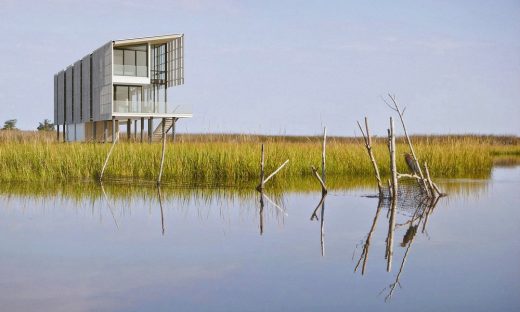
visualization : Parnagian Architects LLC
Salt Box Residence in Mantolokingn
Sojourner Truth Apartments, New Brunswick, NJ 08901
Design: Elkus Manfredi Architects
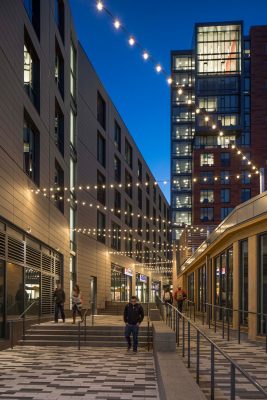
photo © Brad Feinknopf Photography
Sojourner Truth Apartments
The Modern, Fort Lee
Design: Elkus Manfredi Architects
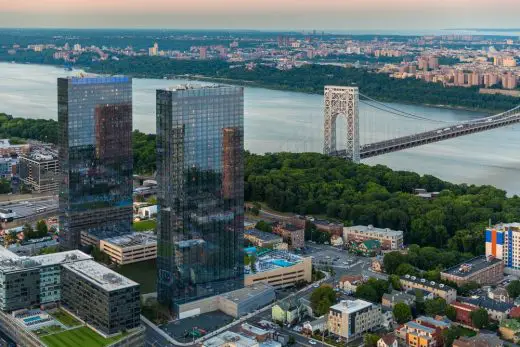
photo © Evan Joseph
The Modern at Fort Lee
Lewis Arts Complex Princeton University
Design: Steven Holl Architects
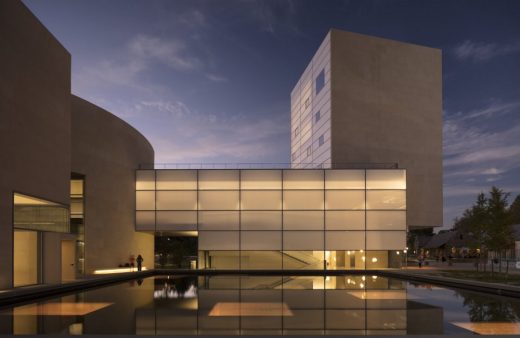
photo © Paul Warchol
Lewis Arts Complex Princeton University Building
230 Halsey Street, Newark
Design: Richard Meier & Partners Architects
230 Halsey Street in Newark
Architecture in USA
Comments / photos for the Jean & Ric Edelman Fossil Park Museum, NJ design by Ennead Architects + KSS Architects page welcome

